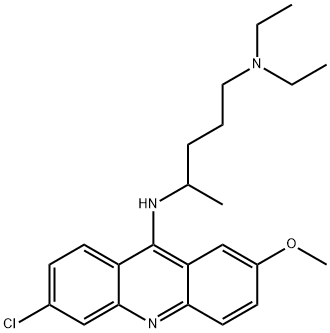CHEMICAL AND PHYSICAL PROPERTIES
| Physical Description | Solid |
|---|---|
| Color/Form | Bright yellow crystals |
| Melting Point | 248-250 °C |
| Solubility | Slight |
| LogP | 5.5 |
| Stability/Shelf Life | Sensitive to light. /Quinacrine hydrochloride/ |
| Dissociation Constants | 10.3 |
| Other Experimental Properties | Upon decomposition emits NOx |
COMPUTED DESCRIPTORS
| Molecular Weight | 400.0 g/mol |
|---|---|
| XLogP3 | 6 |
| Hydrogen Bond Donor Count | 1 |
| Hydrogen Bond Acceptor Count | 4 |
| Rotatable Bond Count | 9 |
| Exact Mass | 399.2077403 g/mol |
| Monoisotopic Mass | 399.2077403 g/mol |
| Topological Polar Surface Area | 37.4 Ų |
| Heavy Atom Count | 28 |
| Formal Charge | 0 |
| Complexity | 461 |
| Isotope Atom Count | 0 |
| Defined Atom Stereocenter Count | 0 |
| Undefined Atom Stereocenter Count | 1 |
| Defined Bond Stereocenter Count | 0 |
| Undefined Bond Stereocenter Count | 0 |
| Covalently-Bonded Unit Count | 1 |
| Compound Is Canonicalized | Yes |
PRODUCT INTRODUCTION
description
Quinacrine is a member of the class of acridines that is acridine substituted by a chloro group at position 6, a methoxy group at position 2 and a [5-(diethylamino)pentan-2-yl]nitrilo group at position 9. It has a role as an antimalarial and an EC 1.8.1.12 (trypanothione-disulfide reductase) inhibitor. It is a member of acridines, an organochlorine compound, an aromatic ether and a tertiary amino compound. It derives from a hydride of an acridine.
